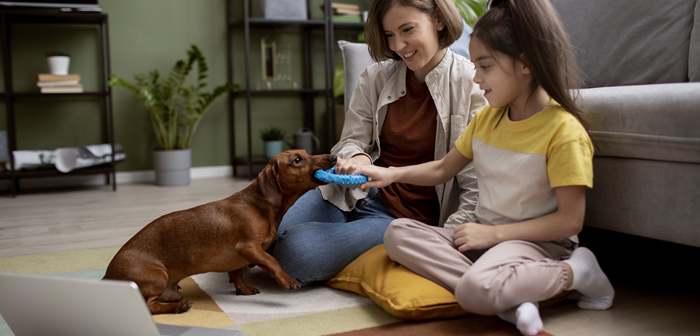The life of a mom never has a chance of slowing down. In between all the daily rush, like making the school runs, planning for meals, and work, dog training appears extremely impossible to manage. However, a well-trained family dog around the household adds a great structure, safety, and joy to your regular chores or store runs. You need not spend hours; all you need is to work smart and devise time-efficient strategies that fit flawlessly into your schedule. Equipped with the right approach, dog training may turn from a less hectic chore and a considerably rewarding habit. The busy moms today often experience success in dog training, especially when they have small dog breeds like Mini Aussiedoodles.
Why Early Training Helps Create a Safer, Calmer Household
Starting sooner sets the tone right to calm your pup’s long-term behavior. It also provides the best structure during chaotic days, supporting seamless interactions with guests and kids.
- Stop Habits Before They Start: Jumping, nipping, or barking becomes too tough to undo once they get ingrained.
- Tailor Training to Breed Traits: Few breeds, mainly those compared in the Cavapoo vs Cockapoo debates, respond ideally with the low-energy, consistent routines ideal across the bustling households.
- Support Safer Playtime: Fundamental commands like “leave it” or “stay” can help prevent rough interactions with visiting kids or toddlers.
- Build Communication Early: Dogs are early learners and understand the rules faster when they are introduced clearly during the initial weeks at home.
- Fit Training Into Routines: Teaching your dog to sit during the meal preparation time or stay at the door can help reinforce their calm behavior as part of your regular routines.
Smart Training Strategies Tailored to a Busy Mom’s Schedule
Today’s mothers often juggle several responsibilities, with time that is rarely on their side. Dog training need not become intensive. It has to become more repeatable, practical, and designed around your lifestyle. If your pup is playful like a Cavapoo, consistency can make a huge difference.
Start With Morning Training When Energy Is High
You may be dealing with busy, loud mornings; however, a 5-minute walk after your breakfast can add wonders to your life. Dogs, like humans, are most attentive during these earlier times of day. The leash-practice or sit-and-stay drills right before the school drop-off set the productive tone right for you and your furry companions. You can proactively use this time as part of a flourishing approach to pet care that helps our dog feel valued and mentally engaged. The zest full of energy is managed effortlessly whenever your dog gets a task at hand.
Focus on Energy Levels and Time Commitment
It is important to select a dog that fits your availability and energy levels. Few dog breeds constantly need long walks and stimulation, which may fail to match a household that is jam-packed with a calendar. Some breeds are satisfied with short playtime and silent companionship. It is important to consider factors like temperament and prey drive in dogs, which can help in outlining the frequency and length of the training sessions.
Use Consistent Commands and Keep Sessions Short
Clear, repeated phrases can help your dog know your expectations. Try shifting your language frequently while sticking to the simple commands like “stay”, “sit”, and “leave it.” Dogs grow up around households with consistency, and toddlers often mimic your cues, which helps to reinforce the training naturally. Always keep things simple, aligning with how to be a financially-fit pet parent, as a consistent level of training sooner can prevent expensive behavior issues in the future. Restrict the sessions to 5-10 minutes to avoid overloading your dog or disrupting your daily schedules. The short bursts are more effective than an hour-long session of drills.
Make Use of Mealtimes for Reinforcement
Using training around food is the most effective and time-saving drill. Before you lay down the dog’s bowl, use it as a scope to practice the commands like “sit”, “wait”, or “take it”. This way, your dog starts associating good behavior with the rewards without you having to devote extra time. Although the meals are the perfect time for indoor reinforcement, associating these habits with the best outdoor activities can help strengthen your pup’s attention and obedience. It helps in minimizing their begging habits at the dinner table, which is extremely important if you have your toddlers eating finger foods.
Involve the Kids—It Strengthens Their Bond
Preschoolers can also reinforce the training cues. As moms, start assigning small jobs to your kids, like calling the dog or tossing a toy after a correct response. This forms a shared responsibility that makes your pup more responsive to all family members and keeps your child engaged. Research by the American Kennel Club highlighted that children who participate in dog training start developing their leadership skills and empathy faster.
Use Crate Time for Structured Breaks
The dogs should visualize the crates as not punishments but safe zones. Whenever your day turns hectic, place your dog in the crate with a chew toy. This offers you a space to cook dinner or manage the homeowner time, free from any interruptions. Crate training can help build independence in your small dog breed and help manage separation anxiety. The small dog breeds often form strong attachments, and they benefit from learning to relax in a structured rest zone. Dogs who are trained in this manner are less reactive and highly adaptable during the regular chaos.
Tap Into Enrichment Toys for Mental Stimulation
Busy moms cannot afford to head outside for a short walk. When naptime runs long or on rainy days, try using puzzles or treat-dispensing toys. Mental stimulation often burns off that extra energy, preventing any destructive behavior. A tired mind is often similar to a calm pup. Purdue University’s College of Veterinary Medicine conducted research supporting that cognitive engagement significantly reduces stress in family dogs.
Use “Place” or “Spot” Training for Multitasking
This is the command that teaches your dog to sit and stay in a dedicated location like a mat or a bed. It is specifically effective during your vacuuming or when you handle your guests at the dog. Making your dog sit quietly in their place allows you to multitask without them jumping, barking, or leash wrangling. Practicing during the dinner preparation time or laundry folding helps to build an automatic, calm behavior in your dog.
Make Use of Transitional Moments
Busy moms often shuffle from one task to the other all day, doing laundry, dishes, or helping their kids with homework. These transitional times are the perfect ones for some quick training opportunities. Command your dog to “sit” or “stay” right before moving to the next room or opening the door. Over time, these small exercises help build responsiveness and discipline. Here, you need to carve out extra time; just adjusting the training into the normal flow can help. It is the perfect approach that helps to reinforce that your pup should look at you for cues, even in casual daily situations.
Keep Calm During Setbacks
Each dog often tests limits, and not all sessions turn out smooth. When things go off track, the pet parent needs to maintain their calmness. Raising your voice or showing your frustration confuses your dog, delaying the overall progress. Instead, try pausing, breathing, and resetting. Patience and consistency are the key to achieving perfect. If your pup is responding today, then they will have wonders awaiting you in the future. Even the breeds that are naturally eager, like Cockapoo, need time to learn the new commands and follow them. Rely on the process and remember that each step, irrespective of its size, can help you move forward.
Practice Leash Walking Indoors First
Before you head out to the bustling streets, start leash training in your hallway. Focus on gentle guidance and reward-based redirection instead of corrections. Keep the indoor leash sessions short, as this gives you better control and improves your dog’s comfort level without stressing them with any sort of outdoor distractions. Over time, your walks will become a welcoming break instead of an overwhelming event.
Know When to Ask for Help
Time often runs out, or frustration starts showing even when you have the best intentions in mind. Mobile dog trainers, online courses, or weekend group classes offer convenient support. You can also choose professional support to get expert input if your dog starts exhibiting aggression or anxiety, or does not respond to your commands. Delegating these tasks will reshape your life into becoming the perfect and resourceful pet parent.
Conclusion
Even when you are a busy mom, training your pup does not require a huge time investment. If you start building your schedules around your daily life, then even the busiest moments can turn into a learning opportunity for your dog. A responsive and calm dog can make your home peaceful, and with small, consistent efforts, you can gain some huge rewards. All you need is a bit of creativity and patience to make training less like a chore and more like a natural part of your household flow.




